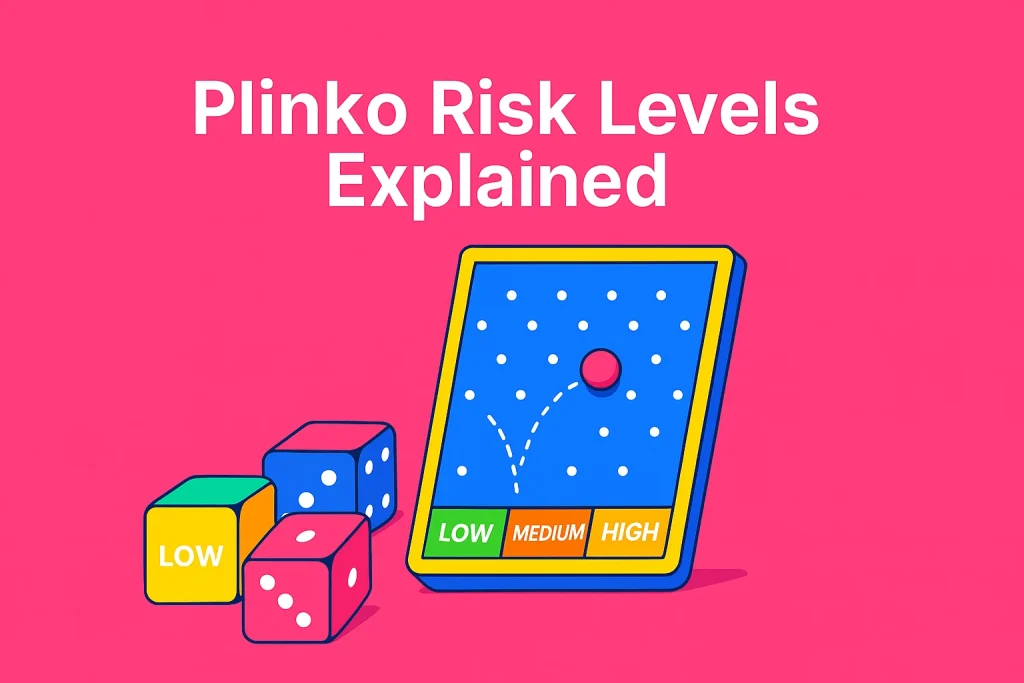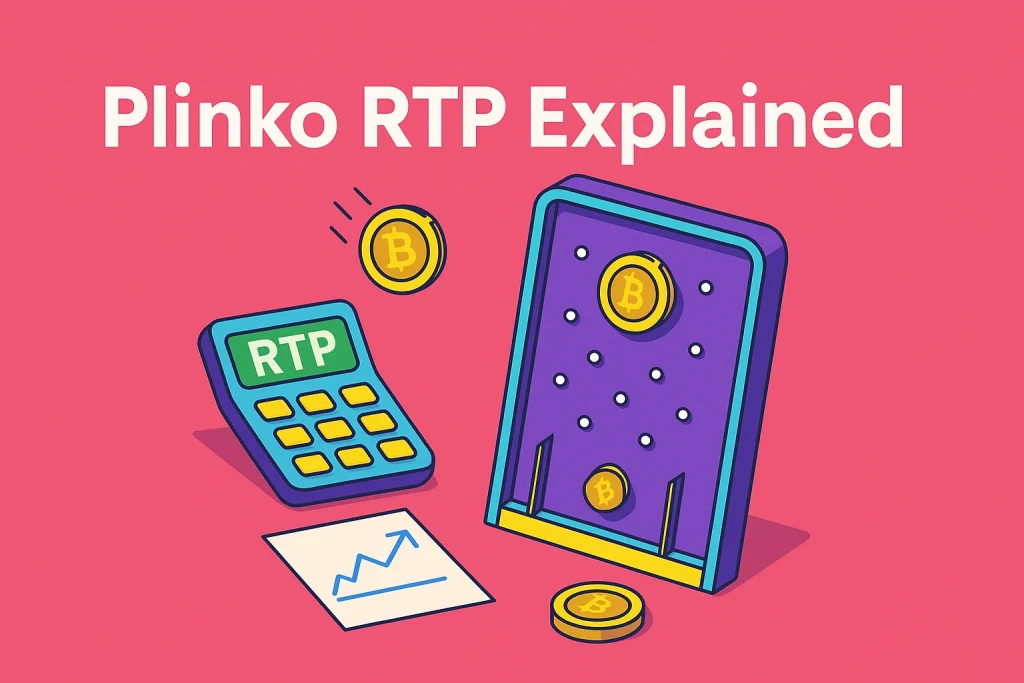Plinko might look simple at first glance. Drop the ball, watch it bounce, and hope for a lucky landing. But beneath that simplicity lies the most important decision you’ll make: choosing your risk level. Low, Medium, or High risk doesn’t just affect the size of multipliers. It reshapes volatility, bankroll survival, and how much excitement you’ll feel during a session.
This guide explores exactly how Plinko risk levels work, compares BGaming vs. Spribe setups, and explains how rows interact with volatility. If you’re ready to play right away, start with our curated list of the best crypto Plinko sites.
What Do Risk Levels Mean in Plinko?
Plinko differs from traditional casino games because you can actively shape the payout structure. Changing the risk setting doesn’t alter the physics of the drop—it redistributes the multipliers. That one tweak is enough to transform your entire playing style.
- Low Risk
- Most multipliers are concentrated around the center slots.
- Expect frequent wins, but usually smaller ones.
- Suits conservative players who want long sessions without big bankroll swings.
- Medium Risk
- Balances small, mid, and occasional big wins.
- Ideal for players seeking excitement without extreme volatility.
- A popular default for those testing strategies.
- High Risk
- Jackpots sit on the far edges, often reaching x500+.
- Dead spins are common, but the thrill factor is unmatched.
- Suited for streamers, high-rollers, and adrenaline seekers.
For a tactical breakdown of betting methods, see our Best Crypto Plinko Strategies guide.

BGaming vs. Spribe: How Providers Handle Risk
Not all Plinko games are created equal. Providers decide how risk and RTP interact. Let’s compare the two most popular names:
BGaming Plinko
- Advertises a 99% RTP across modes, meaning just a 1% house edge.
- Offers 8–16 rows, plus Low, Medium, and High risk settings.
- Max multipliers can reach x1,000, but frequency shifts smoothly with risk.
- This makes BGaming the most “bankroll-friendly” provider for long-term play.
Spribe Plinko
- Averages around 97% RTP, which is higher edge for the house.
- Known for sharper volatility jumps in High Risk mode.
- Max multipliers are slightly lower, around x555.
- Streamers love Spribe Plinko because the variance creates drama on-screen.
Bottom line: If you care about stretching your balance, BGaming is the stronger choice. If you care about excitement and streaming-worthy swings, Spribe delivers.
Transparency matters. Both providers use provably fair algorithms. Learn how verification works in our Crypto Plinko Provably Fair guide.
Rows & Volatility: The Hidden Factor
Risk level alone doesn’t tell the full story. Rows—the number of pegs—also influence variance.
- 8 Rows
- Fewer paths, tighter distribution.
- Safer for quick play and testing strategies.
- 12 Rows
- The “standard” format, balancing volatility.
- Offers enough spread without extreme swings.
- 16 Rows
- Widest distribution, extreme volatility.
- Edge multipliers feel farther away, but jackpot potential rises.
Example: Playing 8 rows with High Risk feels manageable—wins are scarce but not impossible. Switch to 16 rows with High Risk, and the game becomes a rollercoaster where bankrolls vanish or explode fast.
Want to know why outcomes remain fair across setups? See our Crypto Plinko Fairness guide.
Low vs. High Risk Strategies in Practice
Your approach changes drastically with each mode. Let’s break down practical strategies:
Low Risk Approach
- Bankroll: $100 budget
- Bet Size: $1 per drop
- Outcome: Frequent small wins extend playtime, offering steady engagement.
Medium Risk Approach
- Bankroll: $100 budget
- Bet Size: $2 per drop
- Outcome: Mix of safe hits and occasional bigger multipliers. Balanced for casual players.
High Risk Approach
- Bankroll: $100 budget
- Bet Size: $5 per drop
- Outcome: Fewer wins, long dry streaks, but a shot at massive jackpots. Ideal for thrill-seeking sessions rather than grind play.
Remember that RTP interacts with these choices. For a full breakdown, see our Plinko RTP Explained.
Real-World Comparisons: Plinko vs. Other Crypto Games
To appreciate how unique Plinko’s risk structure is, compare it to other fast crypto games:
- Dice
- Often offers a house edge as low as 1%.
- Player sets exact win probability.
- Pure math game—great for grinders.
- Mines
- RTP around 97%, volatility depends on how many mines you select.
- High risk feels similar to Plinko High mode.
- Keno
- Lottery-style variance. RTP ~96–97%.
- Small chance for big wins, long dry spells.
Plinko sits comfortably between Dice and Keno. It offers more excitement than Dice without the punishing volatility of Keno, while still remaining customizable.
Which Risk Level Is Best for You?
Choosing a risk mode is less about “best” and more about matching your goals:
- Beginners → Low or Medium risk, stable returns, safer sessions.
- Casual players → Medium, a versatile balance between small and big wins.
- High-rollers & streamers → High risk, designed for entertainment and jackpots.
The game’s flexibility is its biggest selling point. You can treat it like a long-term grind, or a high-voltage gamble, depending on your preference.
At the end
Risk levels are what make Plinko stand out. Your choice between Low, Medium, and High directly impacts variance, payouts, and play style. BGaming’s near-99% RTP makes it the smart pick for value hunters, while Spribe’s sharper volatility caters to thrill-seekers.
Ultimately, there’s no universal setting—only the right one for your goals. Whether you want steady gameplay, balanced volatility, or big-win excitement, Plinko adapts to your style.
If you’re ready to try for yourself, check where you can play Plinko at top-rated crypto casinos in 2025.
Does High Risk increase RTP?
No. RTP is set by the provider. High Risk simply shifts multipliers and increases volatility.
Which risk level is best for beginners?
Low or Medium risk. They deliver more consistent returns and help you understand the game flow.
Do more rows increase payouts?
More rows increase volatility, not RTP. They make edge jackpots harder to hit but raise potential multipliers.



